Found a Screw In Your Tire? (Do THIS… Not THAT)
You’re driving along when suddenly you feel a thump and the car starts vibrating. You pull over to find a big screw embedded in your tire tread. Uh oh, now what?
Finding a screw or nail stuck in your tire can easily ruin your day, but don’t stress too much. Keep reading to learn what you should (and SHOULDN’T) do if you find yourself in this situation.
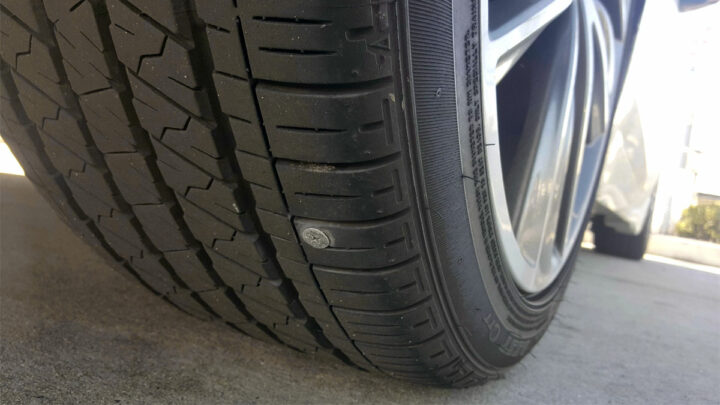
What To Do If You Find a Screw In Your Tire
The following items should be taken into consideration when addressing a newly discovered screw within a vehicle’s tire. Such consideration will assist you in accurately assessing the need for repair.
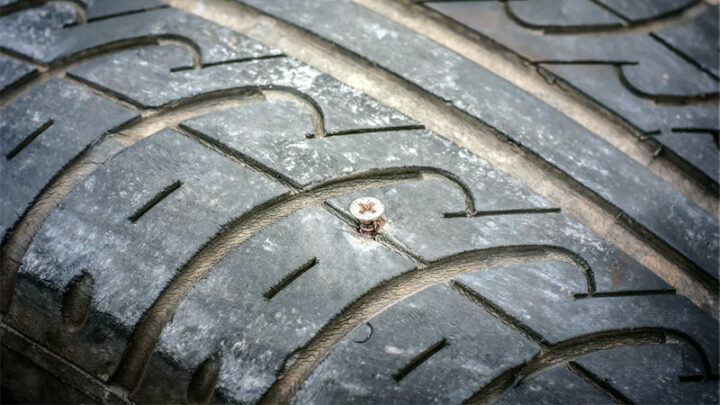
On the Road vs At Home
If you are on the road when a screw-related puncture is noted, you will be forced to make an important judgment call. If a check of the affected tire’s pressure reveals little to no air loss, you are likely safe to drive to the nearest tire shop for repair.
On the contrary, if the affected tire has begun to go flat, you will have to install the vehicle’s spare tire or opt for temporary roadside repair with the use of a tire plug kit and portable tire inflator.
In these situations, it bears mentioning that the use of Slime or Fix-A-Flat products is not advised on TPMS-equipped wheels.
When a puncture of this type is noticed at home, the best option is always to play it safe and install the vehicle’s spare tire. Alternatively, if no spare is available, the vehicle can be jacked up in place, at which time the punctured tire can be removed.
In either event, the affected wheel/tire combo can be taken to a local tire shop for carry-in service.
Related: How Long (and Fast) Can You Drive on a Spare Tire?
Leaking vs Not Leaking
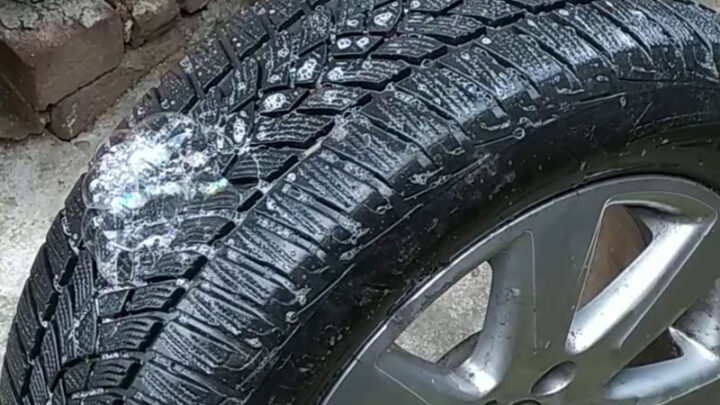
Not all screw punctures are the same. In fact, some do not reach a tire’s inner liner, thereby failing to cause an actual leak.
When assessing a screw-related puncture, soapy water or glass cleaner distributed from a spray bottle can be used to judge whether a true leak exists. Simply spray the screw liberally, while looking for signs of progressive bubbling. This bubbling would signify the presence of an actual leak.
Location of Screw (Tread vs Shoulder vs Sidewall)
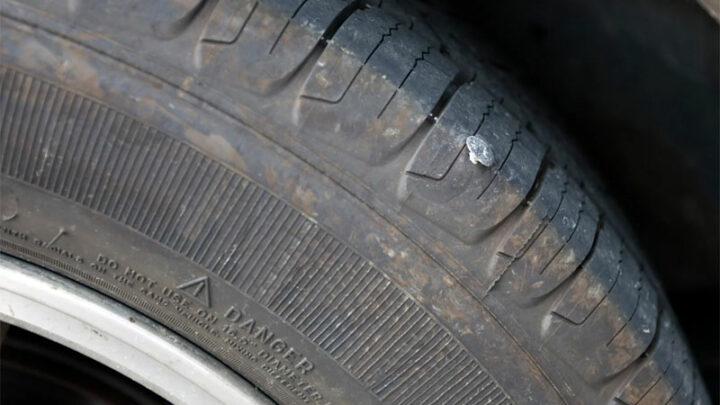
Unfortunately, not all tire punctures are repairable. Only those contained squarely within a tire’s tread are safe to repair, assuming the hole in question is not too large.
Punctures originating in a tire’s shoulder or sidewall serve as grave safety risks, thereby necessitating the replacement of the tire as a whole. Generally speaking, any puncture situated closer than two finger-widths inboard of a tire’s shoulder is considered non-repairable.
Depth of Screw (Puncture vs Outer Tread Layer)
As mentioned above, not all screws puncture as deeply as others. While one screw might pierce deeply, compromising a tire’s inner liner, another might bury a little deeper than a tire’s outer tread, thereby producing no actual leak.
When in question, one should employ the use of soapy water or glass cleaner as described above, to determine the actual severity of the puncture itself. If this testing reveals no detectable leak, the offending screw should be turned counterclockwise to remove it from the tire’s tread.
How Did the Screw Get There?
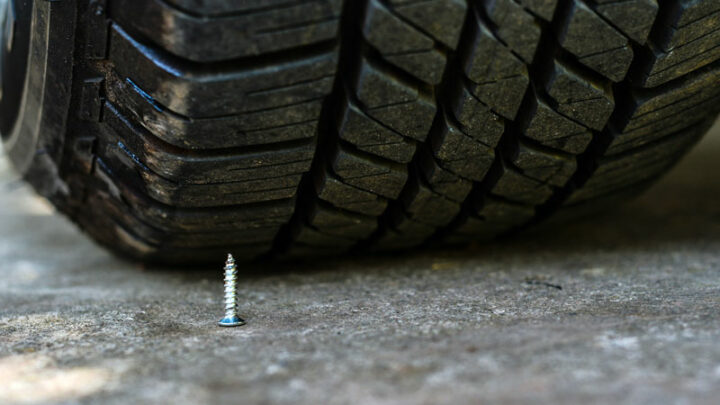
A screw can end up in a tire in many different ways. However, in almost every scenario, such a mishap starts with the loss of construction-related materials along the roadside.
For this reason, you might notice a higher rate of flat tires occur around newly constructed sub-divisions, or in growing industrial parks or neighborhoods.
Lost or discarded screws are piloted into a tire whenever driven over by the vehicle in question, under the force of its own weight. Simply put, a screw becomes embedded in a tire whenever it happens to be positioned at the right angle as the much heavier vehicle drives over the top of it.
How Long Can You Drive With a Screw in Your Tire?
The distance that can be driven with a screw embedded in a tire differs on a case-by-case basis. As previously mentioned, a screw often saves as a makeshift plug of sorts when still embedded in the affected tire.
Nonetheless, in almost every case, a certain degree of air loss still persists. The greater this air loss, the quicker the affected tire will go flat.
In any event, a punctured tire should be serviced as soon as possible. You should never attempt to drive for extended periods of time with one or more of your tires in this condition. If you do not feel comfortable making such repairs yourself, you should take your vehicle to a trusted tire shop at the first available opportunity.
Related: How Long Can You Drive With Slightly Low Tire Pressure?
Repair vs Replace

The decision of whether to repair or replace a screw-punctured tire often comes down to the location of the screw, and the overall condition of the tire itself.
Assuming that this puncture lies squarely within the tread of the tire, and the tire’s tread is of ample depth, repair should be considered the most viable/feasible option.
However, if the offending nail lies in a tire’s shoulder or sidewall, no safe manner of repair exists, thereby necessitating a replacement.
Likewise, a punctured tire should always be replaced rather than repaired if it is significantly worn or otherwise damaged. In fact, most tire shops will refuse to repair tires that are in only marginal condition.
In most cases, it’s best to replace both tires on the same axle so you have a similar amount of tread. Driving dynamics can change quite a bit when tires have a large difference in tread or are two different brands.
With all-wheel drive vehicles, you may even need to replace all four tires for the same reason. Consult your owner’s manual as it will typically provide recommendations based on remaining tire tread.
Should a Nail in a Tire Be Treated the Same?
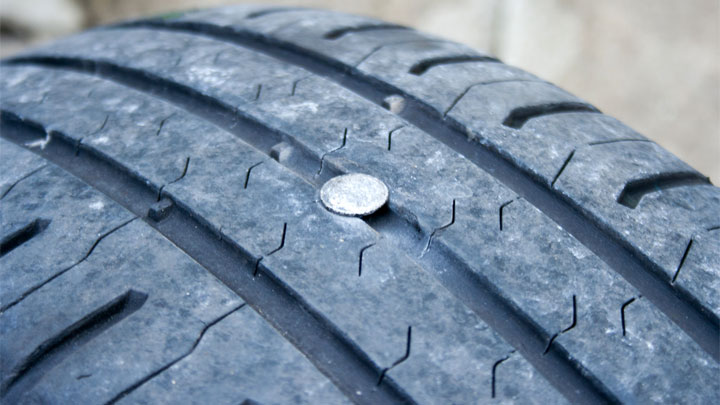
A nail in a tire should be treated in much the same way as a screw would be treated, in terms of the need for repair. However, one should typically place increased urgency upon seeking such repairs due to the differences in construction between a nail and a screw.
While a screw is threaded, a nail is smooth-shanked, making it susceptible to being slung from a tire’s tread under centrifugal force. As a result, increased importance should be placed on seeking prompt repair.
How Much Does it Cost to Repair a Tire From a Screw?
The cost of repairing a screw-punctured tire is often minimal. In fact, one should seldom expect to pay more than $20 to have their vehicle’s tire repaired, as the repair itself is rather simple and quick to complete, assuming that the shop in question has the right equipment at its disposal.
Some tire shops, such as Discount Tire or Les Schwab, will even provide this service for free as a matter of convenience.
See Also: Average Cost of Wheel Alignment
Is It a Good Idea to Use a DIY Tire Repair Kit?
While a DIY tire repair kit can come in clutch when someone finds themselves in desperate need of roadside tire repair, there is no substitution for a quality “tire-off” repair, such as those conducted at most tire shops.
While DIY repair kits typically utilize rope plugs that simply fill the void left by the screw in question, tire shops almost exclusively utilize combined patch/plug combos, thereby providing a more stable internal/external repair.
Does Insurance Cover Tire Damage From a Screw?
In some cases, those with full or comprehensive auto insurance might be covered in the event that one of their vehicle’s tires is punctured by a screw or nail. However, it is worth keeping in mind that the prospect of such often varies on a policy-by-policy basis.
If you have any doubts or questions pertaining to your coverage, a quick call to your insurance agent should provide clarity.
Also of note is the fact that many tire shops and tire manufacturers offer additional road hazard warranties that offset the costs associated with puncture-related tire repair and replacement. Therefore, it is important to check with the vendor of your tires before paying for any services of this type.
- 5 Symptoms of an EVAP Leak (and Repair Cost) - Apr 27, 2024
- P0480 Code (Symptoms, Causes, and How to Fix) - Apr 19, 2024
- Car Temperature Gauge Stopped Working? (Here’s Why) - Apr 15, 2024

If you can see the offending nail or screw in your tire, it's VERY important to ignore the overwhelming urge to immediately pull it out from its point of intrusion.
This stems from the fact that doing so can quite possibly lead to a much quicker loss of air/tire pressure, as the screw itself often serves as a makeshift plug of sorts, while still anchored in place.